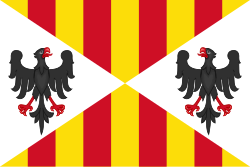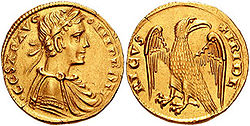Kingdom of Sicily
The Kingdom of Sicily was a kingdom that existed in southern Italian Peninsula, what is now Sicily, Calabria, Basilicata, Apulia, Campania, and Molise.
Kingdom of Sicily | |||||||||
|---|---|---|---|---|---|---|---|---|---|
 The Kingdom of Sicily in 1190. | |||||||||
| Capital | Palermo | ||||||||
| Government | Feudal monarchy | ||||||||
| King | |||||||||
• 1130–1154 | Roger II (first) | ||||||||
• 1266–1282 | Charles I of Anjou | ||||||||
• 1759–1816 | Ferdinand III (last) | ||||||||
| Legislature | Parliament | ||||||||
| |||||||||
History
Norman conquest
The Kingdom of Sicily succeeded the County of Sicily which was created in 1071 during the Norman conquest of the peninsula.
Angevin rule
In 1282, there was a revolt against the Angevin rule, it threw off Charles of Anjou's rule of Sicily. The Angevins are able to maintain control in the main part of the kingdom which became commonly known as the Kingdom of Naples, named after its capital, Naples.
Crown of Aragon
From 1282 to 1409, Sicily was ruled by the Crown of Aragon. After 1302, the island kingdom was sometimes called the Kingdom of Trinacria,[1] In 1816, the Kingdom of Sicily merged with the Kingdom of Naples to form the Kingdom of the Two Sicilies.
Kingdom of the Two Sicilies
In 1861, the Kingdom of the Two Sicilies was invaded and conquered by an Expedition Corp (Expedition of the Thousand) led by Giuseppe Garibaldi during the Italian unification. After a referendum, Two Sicilies was annexed by the Kingdom of Sardinia. Later, with several other northern city-states and duchies, formed the new Kingdom of Italy.
Kingdom Of Sicily Media
Church of the Holy Spirit in Palermo
Martin I, King of Sicily in 1390–1409
Philippe de Villiers de l'Isle Adam takes possession of the island of Malta, 26 October 1530 by René Théodore Berthon
La Palazzina Cinese di Palermo, built by Ferdinand III of Sicily
References
- ↑ N. Zeldes (2003). The Former Jews of This Kingdom: Sicilian Converts After the Expulsion, 1492–1516. BRILL. pp. 5, 69, 296–97. ISBN 90-04-12898-0.









